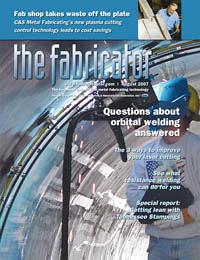Contributing editor
- FMA
- The Fabricator
- FABTECH
- Canadian Metalworking
Categories
- Additive Manufacturing
- Aluminum Welding
- Arc Welding
- Assembly and Joining
- Automation and Robotics
- Bending and Forming
- Consumables
- Cutting and Weld Prep
- Electric Vehicles
- En Español
- Finishing
- Hydroforming
- Laser Cutting
- Laser Welding
- Machining
- Manufacturing Software
- Materials Handling
- Metals/Materials
- Oxyfuel Cutting
- Plasma Cutting
- Power Tools
- Punching and Other Holemaking
- Roll Forming
- Safety
- Sawing
- Shearing
- Shop Management
- Testing and Measuring
- Tube and Pipe Fabrication
- Tube and Pipe Production
- Waterjet Cutting
Industry Directory
Webcasts
Podcasts
FAB 40
Advertise
Subscribe
Account Login
Search
Ridin' the storm out Part I
Part I: Lean helps stamper squeeze out “automotive 5 percent”
- By Kate Bachman
- August 8, 2007
- Article
- Shop Management
Editor's Note:This is the first article in a three-part series on Tennessee Stampings LLC. Part I explores the company's lean practices. Part IIin the September issue discusses how the company's use of sensors and mistakeproofing led to its growth. Part III, which will appear in the October issue, examines the company's facility expansion, addition of a transfer press, and installation of an underground conveyor system.
Tennessee Stampings, Portland, Tenn., manufactures ride control components—struts and shocks—for the automotive industry.
While other stampers crashed because of the double-whammy of the historically high material prices of 2004 and offshoring, Tennessee Stampings' unswerving determination to remain intact drove it to face the issue head-on—assuming "takeover" work and dies from several of the companies strewn roadside by the storm.
Mastering the Rule of 5 Percent
Although Tennessee Stampings is a Tier 2 supplier, it still feels many of the same pressures as Tier 1 suppliers do to squeeze that infamous 5 percent annual price reduction required by automakers.
"If you're going to be an automotive supplier, you've got to get 5 percent cost reductions every year," said Greg Cornett, plant manager. "There's no option. You sign a contract—'You're going to give us 5,'" he said.
"We're feeling it more and more," Cornett said. "A lot of the Tier 1 requirements are being pushed down to Tier 2 level."
The company has experienced continuous growth for the past decade, and the future looks just as promising. In fact, the company plans to increase sales by another 60 percent within the next two years. "They want to see 5 percent off that somehow. So it's tough. It's a way of business," Cornett said.
Cornett said the company strives to meet those expectations by leaning lean. "Instead of griping about it, you have to get lean and make it happen. That's about the only way you can do it," he said. "ISO TS 16949 is a good example of that."
The company achieved TS 16949 accreditation in 2006. "We're very proud of that," Cornett said. "We are already seeing the benefits of having a robust quality system as a result. Our 2007 PPM [parts-per-million reject rate] is currently at 30, significantly fewer than in previous years."
The stamper recently was recognized for its lean accomplishments by winning the Nashville 2007 Excellence in Manufacturing Award for medium-sized companies.
Growth Leads to Expansion, Contraction
Tennessee Stampings has experienced roughly 23 percent annual growth every year for the last three years. The growth—and opportunities for more growth—drove the company's decision to expand its facility by 40,000 square feet, as well as to get leaner.
When the facility was built in 1998, it was designed to facilitate a smooth, lean work flow. Material was received at the back of the plant; presses were staged where they are now; then parts were stamped, sent through the washer, and shipped out through the other end of the plant. But as the company assumed more work, lean took a back seat to immediate space needs, Cornett said.
Over the years the company accepted a lot of value-added-type work, and so it installed seven welding stations, more presses, and finished-goods racks. "So our process flow throughout the plant was not as smooth as we'd have liked for it to be," Cornett said.
"Once we decided we had to do an addition, we said, 'Let's take a look at our lean process flow. Are we doing things right now?'" Cornett said.
Several teams were formed on the floor, Cornett said, and managers attended lean courses on value stream mapping, quick die change, and other lean strategies at the University of Tennessee's Manufacturing Extension Partnership program. It videotaped its processes to analyze them with time studies.
"During our value stream mapping and videos, we saw a lot of wasted movement, a lot of wasted effort, and redundant handling of parts. So we said, 'OK, let's start as if we had a clean slate.'" The teams, working in conjunction with an outside consultant, suggested new plant layouts, which were then reviewed, combined, and developed, Cornett said.
Part of the 40,000-sq.-ft. expansion included adding a transfer press, moving all of the presses to the new area, and building an underground scrap conveyor running the whole length of the addition to collect scrap from the presses (see Figure 1).
Conveyor Expected to Save 25 Percent
The new layout required six large-tonnage presses to be relocated from existing pits. "Most people would say, 'I'm not going to move all my presses from one side of the plant over to the other side; it just wouldn't be cost-effective,' but in our time studies, we saw that in some cases we were losing 15 minutes out of every hour shutting down our 400- and 500-ton presses to dump scrap. So we said, 'If we can get a 25 percent productivity improvement by not having to dump our scrap with an underground scrap conveyor, is it worthwhile?' So we ran the numbers, and we figured we could justify the underground scrap conveyor with a three-year payback.
"So first we see an immediate 25 percent improvement in productivity by not having to shut the presses off 15 minutes out of every hour.
"Second, if we arrange our presses differently, we can have one operator run two presses instead of one.
"And the third benefit is that with the people I'm freeing up—we're not going to lose those people—we're going to use them on setup teams so that we can eliminate variation from one setup to the next. We do have a very defined setup sheet that informs operators how to locate the die, set up the feed and sensors, counterbalance settings, how many times to spray oil in the die, and what lube ratio to use, but we've still got different people doing it, so we have some variability," Cornett said.
Tracking Measurables
Covering most of one wall in the entrance area is a large tracking board displaying every possible "measurable" for both customers and employees to see (see Figure 2).
"To be a TS 16949-certified company, you have to show evidence that you are actually tracking these different measurables," Cornett said.
One board shows on which vehicles the company's parts are assembled so employees know where our parts go, he said. "We supply just about every automotive ride control manufacturer. We ship to Canada and the U.S., Mexico, China, Germany, and we're looking to expand the market. We've got parts going on Corvettes, Cadillacs, Mitsubishis …."
Reject Rates. The company measures internal and external reject rates in PPM and failure costs. A pay-for-performance program allows an employee to earn a substantial payout every quarter for meeting high productivity and low reject rates. "In the fourth quarter of 2006, we finished up with zero defects—and we ship an average of 25 million parts a quarter," Cornett said. "One thing we've done to keep our PPM low is we catch it early and don't let it get to the customer."
There is good reason the employees focus on quality, he explained. "If you have to do any sorting, rework, and expedited freight to get parts to the customer or materials from our suppliers to make more parts, all that cost goes into the cost of quality and ultimately affects the pay-for-performance payout."
The other part of the program is individual-based. "If an employee finds a bad part, we'll pay him for bringing it out, containing everything, and making suggestions for improvement. Since 2005 the company has paid out more than $15,000 on them. If you look at the issues detected that potentially could have gotten to the customer, it could have cost substantially more in customer rejects. So that's one of the programs that has really driven our PPM down."
Tooling Costs. Because the company does not build its own dies, tooling costs are in the form of die maintenance. "Our goal is not to exceed a certain percentage of sales dollars, so as sales increase or decrease, the amount allowed for die maintenance increases or decreases as well," Cornett said.
Typically, when Tennessee Stampings takes work over from other suppliers, it is expected to fix a flaw or problem that had been tolerated previously, Cornett said. "Customers want us to produce parts better than the previous supplier did; otherwise, they wouldn't have lost the business to start with. So we focus on trying to improve existing conditions.
"On new dies, we spend a lot of time on feasibility and advanced quality planning (AQP)—another requirement of TS 16949. We take this phase of preparing for a die or equipment build very seriously. We have an in-depth check-off list. We'll take a print and we might look at it for hours, all of us, until each department feels comfortable," Cornett said. "Because once that die's built, if something is wrong, you're going to pay for it for the life of that die.
"We know it's better to put whatever time is required into the design phase than to continually struggle with a poorly designed die for the life of the program," Cornett continued. "Once a die is built and the customer has signed off, the supplier is responsible for the costs of any die modifications needed to ensure part quality or performance.
"The reasons our growth and competitiveness have been so good are mistakeproofing and in-die sensor systems."
Safety. The company has an all-or-none bonus program, with goals the company must meet for all employees to receive the bonus. "We like to see no accidents, but fewer than two per quarter pays out a bonus."
Equipment Changeover Time. The company measures all of its equipment downtime. Cornett said that part of achieving TS 16949 is that they are required to do internal audits and show the findings.
Optimal Equipment Efficiency (OEE). One of the factors for measuring OEE is percentage of uptime. "If I had 10 hours to run this press, what percentage of uptime should I be getting? The world-class goal is 85 percent uptime. Right now, on this press, we're hitting 68 percent, so we have room for improvement," Cornett said.
Productivity. The company resets its goals for productivity continuously. A baseline rate was established based on rates obtained in 2005 on 500-ton presses. "To improve we formed a team to figure how we could get our efficiency up to 140 percent. Within six months' time, we had already reached our goal of 140. In 2006 the quarters were 169, 164, 167," Cornett said.
"We did this by doing videos of changeovers, determining what was waste and what was value-added, and worked to eliminate the waste. It really has paid off."
Takt Time. Takt time is the rate or time it takes for a complete product cycle, established by the rate at which your customer buys your product, according to www.isix sigma.com. For example, a takt time of two minutes means that your customer is buying a complete product or assembly at the rate of every two minutes, and you produce that product or assembly every two minutes.
"One thing we're trying out now is a real-time takt time tracking," Cornett said (see Figure 3). "Manual dry-erase boards that operators fill out on an hourly basis are good for determining the bulk of downtime problems, but they fail to detect minor nuisance stops, which can really add up over time. For this reason we are looking to monitor production using a visual electronic board to aid the operator in accurately tracking downtime down to the second."
Steering in a New Direction
One last chart Cornett displays is an organizational position hierarchy chart. Instead of being topped by the president, and then a layer of executives and so on, the order is reversed. "We put the employees on top. We feel that they're the main asset of the company," Cornett said.
"I've been with the company 13 years, and we've never had a lull or layoff. We've had constant growth. I don't see an end to it, as long as there're automotive products being made."
Greg Cornett will give the keynote presentation at the Stamping Journal® Forum on Sept. 27 in Hopkinsville, Ky., entitled "Lean Manufacturing—Creating Flow on the Shop Floor." Cornett will share his insights on lean practices derived from real shop floor experiences at Tennessee Stampings. Topics include:
- Evolution of lean
- 4 P's of lean: philosophy, people, processes, problem-solving
- Key elements of lean: 5S, VSM, standardized work, SMED, pull systems, TPM
- Identifying and minimizing non-value-added activities
- Benefits of lean versus traditional manufacturing
About the Author

Kate Bachman
815-381-1302
Kate Bachman is a contributing editor for The FABRICATOR editor. Bachman has more than 20 years of experience as a writer and editor in the manufacturing and other industries.
subscribe now

The Fabricator is North America's leading magazine for the metal forming and fabricating industry. The magazine delivers the news, technical articles, and case histories that enable fabricators to do their jobs more efficiently. The Fabricator has served the industry since 1970.
start your free subscription- Stay connected from anywhere

Easily access valuable industry resources now with full access to the digital edition of The Fabricator.

Easily access valuable industry resources now with full access to the digital edition of The Welder.

Easily access valuable industry resources now with full access to the digital edition of The Tube and Pipe Journal.
- Podcasting
- Podcast:
- The Fabricator Podcast
- Published:
- 05/14/2024
- Running Time:
- 62:12
Cameron Adams of Laser Precision, a contract metal fabricator in the Chicago area, joins the podcast to talk...
- Trending Articles
White House considers China tariff increases on materials

A visit to Automate 2024 reveals the future might be now

Majestic Steel Arkansas fully operational

Rivian to expand Illinois facility to manufacture midsized SUV

Why employee-owned companies make sense in manufacturing

- Industry Events
Laser Welding Certificate Course
- May 7 - August 6, 2024
- Farmington Hills, IL
World-Class Roll Forming Workshop
- June 5 - 6, 2024
- Louisville, KY
Advanced Laser Application Workshop
- June 25 - 27, 2024
- Novi, MI
Precision Press Brake Certificate Course
- July 31 - August 1, 2024
- Elgin,


























